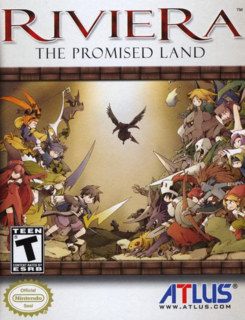Riviera does enough things differently to make it fun to play and stand out from the myriad of mediocre PSP JRPGs.
Riviera certainly keeps a lot of the tried-and-true, but done so much it gets old, JRPG standards: Plucky teen-aged Main character, scantly-clad female characters (though they are somewhat disturbingly pre-pubescent in this game), corny vibrato-filled heroes, etc. Riviera also has some features that make it worse than some -- repetitive (almost useless) background scenes and overly-lengthy tutorial dialog ("you have to use a special ability" "special ability? what's that?" "they're special!" "how so?" "well, let me tell you!" "I'm listening!").
However, there are quite a few things about Riviera that keep it fresh and fun in the "endless" sea of PSP JRPGs.
First, and most importantly, is the gameplay. Exploring is done in an almost board-game style. You don't freely move your characters about. Instead, they'll move onto a single screen where you're shown your options for exits to move through, or specific items to look at. You choose from these options by selecting them with your PSP's buttons, instead of "walking" your character around the screen. For example, on a screen you may see a chest, and there are two exits. You toggle between "look" and "move" modes. When in "look" mode, items of interest on-screen are labeled with arrows -- you then push the directional pad button matching the item you want to investigate, and your character walks there and investigates. When in "move" mode, the exits are labeled with arrows, and you push the d-pad button to move through that exit. It sounds overly constrictive, but actually streamlines the gameplay wonderfully, removing all of the tedious "walking walking walking" you find in most JRPGs. These rooms are tied together into groups, then groups make up "stages", then stages make up "chapters". Between "groups" you can save your game.
When examining in-world items, from bushes to statues to chests, you may be presented with any number of different options. You may get a slot-machine style list of items, and when you push X, the item that appears is yours. You may find a trap which requires you to QUICKLY push a combination of d-pad or X/O/square/triangle buttons to defeat it. Or, you may encounter a monster.
Because of this navigation system, the game is completely linear -- again, almost playing like a board game. There are some points of "free" movement, where you'll move between buildings in a city, but again, you simply pop from place to place, talk to people, and move on.
Combat is pretty straight-forward and is turn-based. Combatants take turns, based on their stats, to attack. An interesting wrinkle is that when entering a battle, you pick 4 items for your entire party to use for the battle. That includes weapons, potions, wands, etc -- ANYTHING you'll use in the battle. This provides a very tactical decision point. You may wish to bring in a long bow (which characters can share during battle), a sword, some potions, and maybe some defensive power-up. Then you carry out the battle. If you discover that the creature is impervious to long bows, you've wasted a slot -- chances are you'll want to go back to a save and replay the battle.
There are a decent number of unique monsters, and the game's linear nature means no random encounters, so the designers try to give each creature you encounter a bit of its own personality and even its own recorded dialog that is somewhat unique in each battle.
When you successfully hit or get hit, a power bar will advance. When the power bar reaches certain levels, you can perform super attacks. Also, your characters will gain proficiency in the weapons they use in battle, granting them special attacks and power-ups with that weapon.
Visually, the game has very traditional, but well-done, hand-drawn cell-shaded graphics. Animation is crude, and is compensated for by using visual effects on still images (dissolve-wipes, flashes of light or color, etc.).
The musical soundtrack is very good, with some decent variety in songs, and is traditional orchestral in style. Most dialog is done through recorded voice-overs, which are also well-done.
Overall,. Riviera is a straight forward JRPG with just enough different wrinkles in the gameplay to make it a unique and fun experience.

